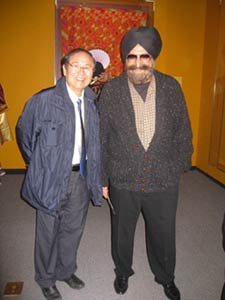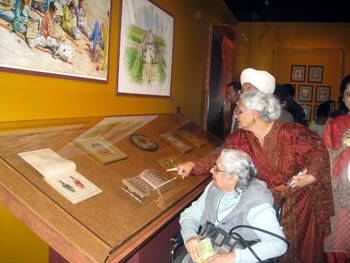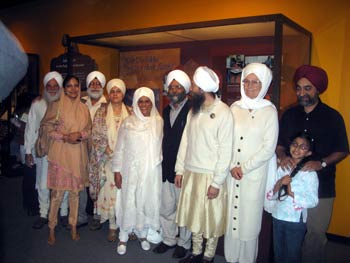Open through May 1, 2009
Santa Barbara Museum of Natural History, CA
They came from Los Angeles, New Mexico, San Francisco, and Sacramento and of course Santa Barbara and beyond. They were art collectors, academicians, businessmen, professionals, students, leaders and people like you and me. They came to enjoy and support the first ever exhibit of Sikh Art, Culture & Religion in Southern California. The exhibit titled “Sikhs: The legacy of the Punjab” opened at the historic Santa Barbara Museum of Natural History, featuring a cluster of old Spanish style buildings at Santa Barbara CA, on 21st of February 2009.
This exhibit showcases to the world a number of Sikh paintings, both early 18th century and contemporary. There are many new works of art, notable paintings by Sukhpreet Singh & R.M Singh, which are been displayed for the first time. Other prominent artists whose works are on display are Arpana Caur, Iswar Singh Chitrakar, Thakar Singh & Kewal Soni & Kanwar Singh & Navjit Singh Chhina.
The exhibit, very skillfully, weaves together the history, culture and religion of the Sikh People. The original weapons of the period of the Sikh empire, the coins of their sovereignty, the manuscripts of their legends, the textiles and jewels which adorned them all tell their own stories. The Punjabi music which visitors can select to listen to brings the hall alive to the beat of the Dhol and other traditional instruments. The exhibit explores all aspects of the lives of the Sikhs and offers a unique introduction of the Sikhs to the non-Sikh Americans as well.
The Opening Reception of the Exhibit was a cultural bonanza which opened with the rendition of the shabad “Awal Allah Noor Upaya” and featured cultural dances performed by young children. The audience was addressed by Mr. Karl Hutterer , Executive Director of the Museum, Dr. N.S Kapany , a major contributor to the exhibit, Bibi Inderjit Kaur and Dr. Sohan Singh Chaudhury, who lauded the contributions of the community , especially the untiring efforts of Mr. Gurdip Malik, to make this happen.

Why it Matters?
As the number of Sikhs in America grows, they share struggles with other immigrant and minority faith groups: how to nurture and preserve their faith in a different culture, how to protect their right to practice it, how to organize, and how to decide who will speak for the community. Discrimination experienced after the 9/11 terrorist attacks forced Sikhs to defend and define their faith. Seven years later, this growing community has raised its profile in cities, workplaces and on campuses across the country and stepped up its fight for civil rights. Museums are recognizing the importance of Sikh art and culture in American society. In July 2004, the Smithsonian's National Museum of Natural History opened "Sikhs: Legacy of the Punjab," followed by the exhibit “I see no stranger” by the Rubin Museum of Art in New York in 2006. Today the Asian Art Museum of San Francisco currently has the only permanent Sikh art gallery, “The Satinder Kaur Kapany Gallery of Sikh Art” in the West.
 Sikhs first immigrated to the United States over 100 years ago. Today, there are 26 million Sikhs worldwide, and over one million in the US, many of them highly successful professionals and entrepreneurs. Yet, because many Sikhs wear turbans and beards as a visible expression of their devotion to their faith, they are often viewed with suspicion. Sikhs first immigrated to the United States over 100 years ago. Today, there are 26 million Sikhs worldwide, and over one million in the US, many of them highly successful professionals and entrepreneurs. Yet, because many Sikhs wear turbans and beards as a visible expression of their devotion to their faith, they are often viewed with suspicion.
This exhibit is supported by the Sikh Heritage Foundation & the Sikh Foundation, and we strongly encourage you to see this exhibit, with your friends & family. Young children especially will be filled with pride and enthusiasm of their heritage.
Directions to the museum
Sikhs: Legacy of the Punjab features a remarkable people whose identity is based on their unique religion. Sikhs: Legacy of the Punjab originated at the Smithsonian Institution’s National Museum of Natural History. We welcome this exhibit to Santa Barbara and hope that it will contribute to mutual understanding among the diverse segments of our community.
|

